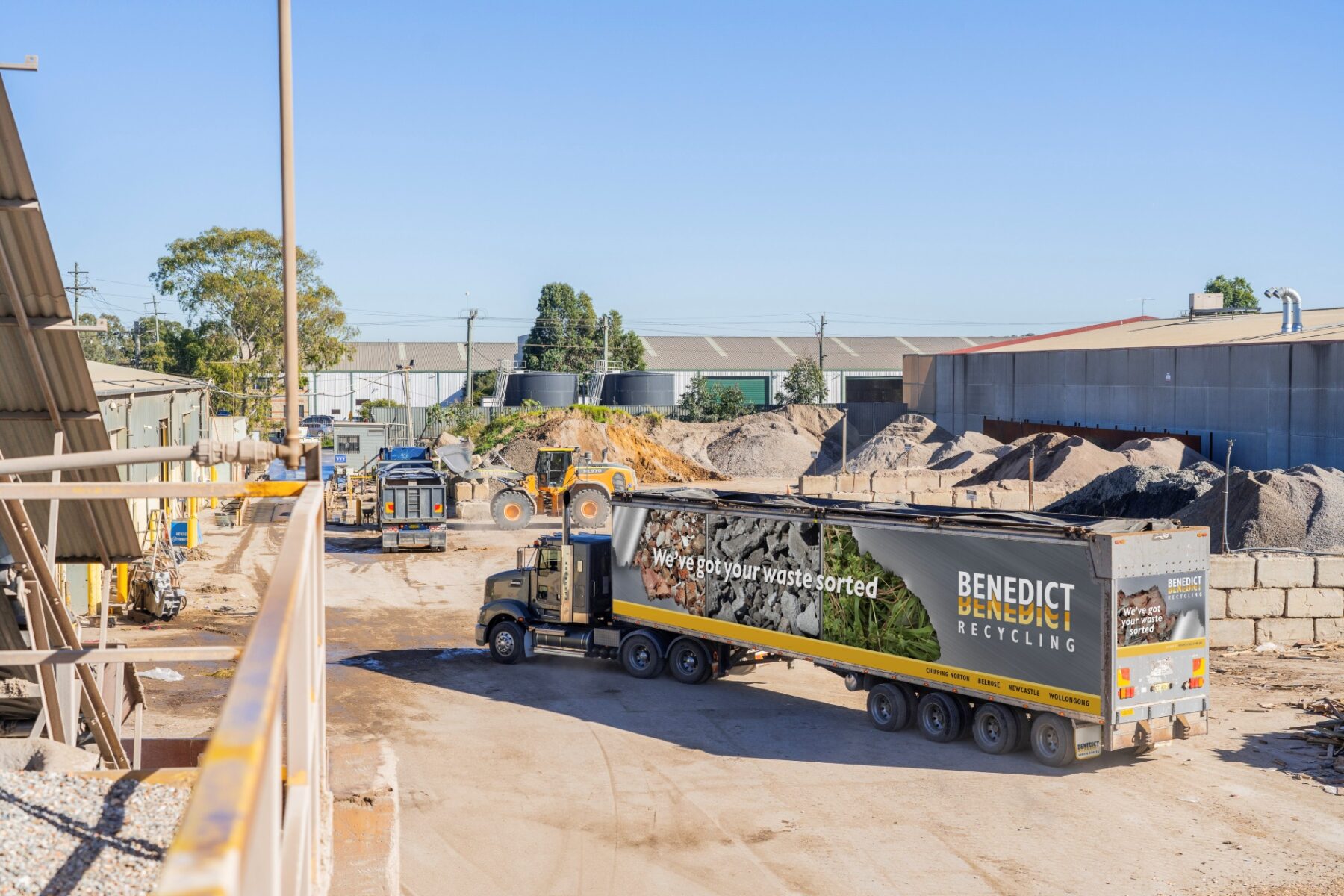INNOVATIVE RECYCLING SOLUTIONS

What is Resource Recovery?
“Resource Recovery maximises the options for reuse, reprocessing, recycling and energy recovery at the highest net value of the recovered material. This encourages the efficient use of recovered resources while supporting the principles of improved environmental outcomes and ecologically sustainable development. Resource recovery can also embrace new and emerging technologies.” NSWEPA
Our Benedict Recycling facilities at Chipping Norton, Belrose, Unanderra, Mayfield West, and Smeaton Grange, are dedicated to increasing resource recovery across a range of waste streams, including General Solid Waste (non-putrescible), Construction & Demolition (C&D) Waste, Commercial and Industrial (C&I) Waste and Industrial Residues that would have otherwise ended up in landfill.
What are the benefits of Resource Recovery?
- According to Government data, less than 10% of the estimated 2.5 million tonnes of C&I waste generated in Sydney each year is currently recycled; the rest of this potentially valuable resource goes straight to landfill. Historically, the main reason for this low C&I recycling rate is due to the wide and disparate range of materials and sizes that it contains, limited markets for its residues, bans on the exporting of its recovered fractions, and the commercial cost of separation. Benedict is currently partnering with a number of parties on a range of solutions for supply of recovered materials for Waste to Energy Fuels and Minesite rehabilitation. This is an example of what will continue to keep Benedict at the forefront of waste recycling in the Greater Sydney Region.
- Construction & Demolition waste normally has a large percentage of recoverable materials that can be readily processed into products for reuse by consumers. These recoverable materials normally include materials such as Timber, Metals, Concrete, Brick, Soil and Sand which in turn are processed to make recycled soils, aggregates, bedding sands and mulches.
- Clearly, the benefits associated with returning materials back to the industry as well-engineered products that are fit for purpose include not only the obvious commercial benefits, but equally many environmental benefits, such as preserving diminishing landfill space and reducing our need for distant virgin Quarry products.
How does Benedict Recycling
recover these resources?
At Benedict Recycling, materials such as wood, metals, paper/cardboard, gyprock, sand, soil, and rubble are separated with a collection of sorting processes. The recoverable materials are separated and reprocessed for use in the production of various civil and horticultural products and these products are produced to meet industry and customer specifications and standards.
If your Company is experiencing difficulty with the disposal of waste or excessive waste disposal costs, please contact Benedict Recycling for help with even the most difficult waste streams. Let us solve your waste problem!
For more information on the benefits of resource recovery for your business please call Mick Williams on 0425 282 202.

Benedict recycling explores a range of emerging technologies
At Benedict recycling we are exploring a range of emerging technologies to recycle our wastes. We already employ traditional units such as fans, screens, magnets, Eddy-current machines, and Near-Infrared Optical sorters. We are currently investigating the installation of optically controlled robots that will safely do manual, repetitive tasks such as picking on waste picking lines.
WASTE STREAMS
Construction & Demolition Waste Streams
What is it?
Construction and Demolition waste is made up of:
- Fines (soils, sands, clays etc)
- Timber (pallets, form boards, and off cuts)
- Plastics (pipes, cable reels, buckets, films, etc)
- Concrete
- Brick/tiles
- Asphalt
- Gyprock
- Rubble (heavy density soils/fines with concrete, brick and/or asphalt inclusions)
- Non – Recyclable Rubbish (carpets, textiles, CCA-treated engineered timbers, windscreen glass, AstroTurf etc)
- Mixed Metals (both non-ferrous and ferrous)
- General Solid Waste (that meets our acceptance criteria and is accompanied by test reports)
- Virgin Excavated Natural Material (VENM) / Excavated Natural Material (ENM)
All your large or small construction and demolition waste volumes are welcome at Benedict Recycling Facilities.
How is it generated?
This waste stream is derived from the following sources:
- Home Builders and Development Companies
- Home Renovators
- Civil Works
- Government Infrastructure Works
- Developers
Commercial & Industrial Waste Streams
What is it?
Commercial and Industrial waste is made up of:
- Timber Pallets/offcuts
- Mixed Plastics (films, bottles, containers etc)
- Mixed Paper and Cardboard (boxes, packaging, office waste etc)
- Glass
- Mixed Metals (both non-ferrous and ferrous)
- Excess/defective (non-putrescible) stock
- Non-Recyclable Rubbish (carpets, textiles, CCA-treated engineered timbers, plate glass, etc)
How is it generated?
This waste stream is derived from the following sources:
- Commercial Factories
- Manufacturing and Distribution Industry
- General Business activities
- Packaging Industries
Residues
Benedict Recycling specialises in assisting businesses with lowering their disposal costs and increasing the recovery rates for their residue wastes that would normally go to landfill. These problematic waste streams come from many different industries including the Scrap Steel Industry and also the Paper and Plastics Recycling Industry, both of which produce significant amounts of waste.
Benedict Recycling is assisting these industries to achieve sound environmental and economic outcomes. We believe that through our innovative sorting technologies we can recover as much as 90% of this material. The recovered material will then end up back in the market as a recycled product for further use.
If you are generating a costly waste stream and would like Benedict Recycling to come and make an assessment, or for your large volume-based rates please contact our Brad Morrin on 0459 950 115.

Waste Tipping Price List
Downloadable Information
Recycled products
The sorting process in our recycling centres includes separating the incoming waste into separate categories of brick, concrete, soil, carboard, timber, metal etc. These products are then processed and turned into valuable, sustainable products and sold back into the industry for use in variety of applications.
Our recycled products have been utilised in some of the major Sydney projects such as the Baragaroo Development, West Connex M4 widening, M2 upgrade, North Connex, Wet’n Wild Recreational Park, Sydney Olympic Park and more.
Benedict Recycling Facilities in Chipping Norton, Belrose and Newcastle
produce and sell large volumes of:
Recycled Bedding Sand (BED/SA)
Recycled Bedding Sand (BED/SA) is made from the crushing and screening of recycled material such as concrete and brick.
This product has been extensively used in the Westconnex Project amongst others and as it is certified to RMS specifications, it is used for their projects as well as many others major projects across Sydney.
Recycled Bedding Sands are a sustainable alternative to natural quarried bedding sands, and also offer a significant cost benefit. We make recycled bedding sand to meet the industry standards, RMS R11 and AS2758.
10mm Recycled Aggregate (10AGGR)
10mm Recycled Aggregate (10AGGR) is the preferred drainage medium utilised by plumbers as a sustainable, economical drainage medium around their pipe work. Recycled aggregates certainly have their place in the market; however they also have some restrictions that make them not suitable for certain applications such as for use in concrete batching, as decorative mulches, and RMS & Sydney Water drainage and pipe bedding applications.
This product was used in the Barangaroo Project as it meets their ‘strict environmental conditions’.
Screened Recycled Soil
Screened Recycled Soil is another great product produced under an EPA RRO at Chipping Norton and Belrose that is externally quality assured to meet the relevant industry standards. This product is first sent to Menangle Sand and Soil’s Quarry where it is blended with natural soil and sand which is then widely used by industry as a turf underlay, growing mediums, filling material to raise levels, mounding material on golf courses and is also beneficial for site soil amelioration.
This product has been used on multiple golf courses and ovals across the Sydney region as well as numerous parkland and civil projects for more than 15 years.



